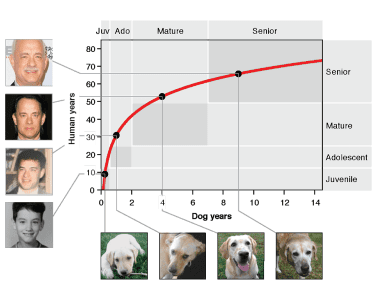The formula is about mid-way through the article, and it includes a simple calculator.

We learn, as kids, to approximate dog age thusly: one dog year for seven human years. That’s a decent approximation in some cases, but the more you think about it, the more it starts to fall apart.
All dog breeds tend to follow a similar pattern: they reach puberty at 10 months old. Right off the bat, it’s clear that the approximation doesn’t work here, as humans don’t really reach puberty at 6 years. Dogs can also reach 20 years or even more, and 140 years has never been recorded for a human. All in all, while it can give a ballpark estimate, the 7-for-1 approach falls short in many regards.
But now, researchers have come up with a much more accurate formula to assess dog age in human years. This one, at least, is backed by science.
It started as a way to detect factors associated with dog aging, and it focused on a relatively new concept: DNA methylation. The idea is that as we age, our DNA undergoes chemical modifications which can be used as a sort of genetic clock. It’s a way of looking at our body’s wear and tear, as the influence of diseases and unhealthy lifestyle can also be observed (to an extent) with this approach.
It’s not just humans that have epigenetic clocks. Other species have them too — including dogs. Geneticist Trey Ideker of the University of California, San Diego, and colleagues, analyzed the DNA methylation patterns in the genomes of 104 dogs (all golden retrievers), ranging from 4 weeks to 16 years of age. Although just golden retrievers were analyzed, the patterns are very similar for all breeds.
There were remarkable similarities between the DNA methylation of dogs and humans. Although the two species diverged a very long time ago, dogs live in similar environments to humans, and they even have access to similar healthcare.
Simply put, the patterns of DNA methylation in young dogs tended to be similar to those in young humans — the same goes for older dogs and older humans.
Finally, the study also demonstrates that these patterns can be used to translate the age-related physiology of one organism (in this case, dogs) to another organism (humans).
The formula is not linear, and is not exactly simple, but here it is:
Human Years = 16 ln(Dog Years) + 31,
where ln is the natural logarithm.

translation from dog age (x-axis) to human age (y-axis). Tom Hanks for scale. Image credits: Wang et al.
The natural logarithm is used because dogs and humans don’t age similarly. Dogs seem to age very quickly in the first part of their life (which is why the age of young pups seem very weird translated into human years), but their ageing process slows down massively compared to that of humans. So the translation dog to human years cannot be linear — it is logarithmic. When your dog is 1 year old, he’s approximately 30 in human years. When he’s 2 years old, he’s 42. He’s around 60 human years by the time he’s 6, but only 70 by the time he’s 12.
It’s a weird thing to wrap your mind around and it is definitely not a perfect translation from dog years to human years, but it works much better than all existing alternatives. It also works to explain why some dogs reach sexual adolescence as early as 6 months old — the onset for that is around 10-14 years for humans. Dogs are adolescent until about 2 years, which in humans lasts until 25 years old. Then, maturity for dogs is around 2-7 years, and for humans around 25-50 years. Similar calculations (but with a slightly different formula) can be carried out for other animals, including cats and mice, researchers conclude.
The study can be read in its entirety for free on biorXiv.






